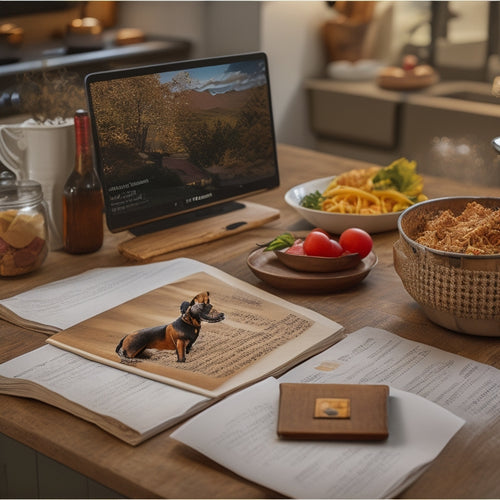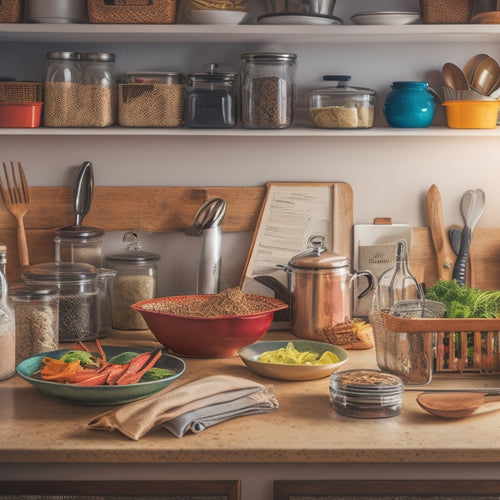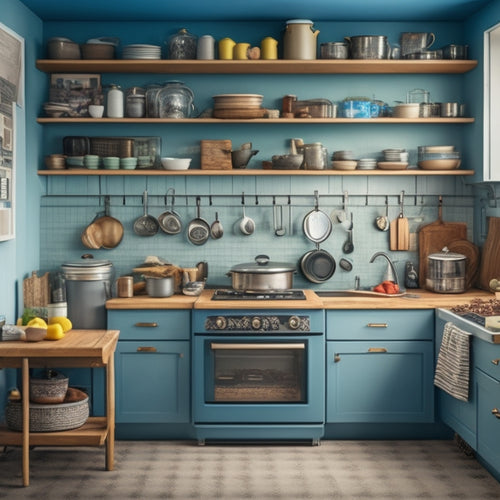
Taming Tupperware Chaos: Mastering Kitchen Cabinet Organization
Share
I've struggled with Tupperware chaos, too. My kitchen cabinets were a jumbled mess, making meal prep a frustrating hunt for the right containers. But I've learned that with the right strategies, I can master kitchen cabinet organization. I start by customizing my containers and using drawer dividers and shelf separators to maintain tidiness. Labels and chalkboard stickers help me quickly identify what's inside. By implementing these strategies, I've transformed my kitchen cabinets into efficient spaces where I can focus on cooking without wasting time searching for items. Now, I'm ready to dive deeper into maximizing storage space and maintaining a clutter-free zone.
Key Takeaways
• Customize containers to fit specific needs, and label them for easy identification and access in kitchen cabinets.
• Implement drawer dividers and shelf separators to maintain tidiness and maximize storage space efficiency.
• Regularly declutter and involve family members in tasks to maintain a clutter-free zone and reduce stress.
• Sort Tupperware by type, size, and frequency of use, and employ labeling tricks for easy identification and access.
• Invest in protective cases for Pyrex containers, and consider cost-effective alternatives for added fragility protection.
Kitchen Cabinet Organization Essentials
What's the secret to a clutter-free kitchen cabinet that saves me time, reduces stress, and makes meal prep a breeze? For me, it's all about having the right tools and systems in place.
I've found that container customization is key - using a mix of shapes and sizes to fit my specific needs. Organizational tools like drawer dividers and shelf separators help keep everything tidy and easy to access.
Labeling techniques, such as using labels or chalkboard stickers, guarantee I can quickly identify what's inside each container. By implementing these strategies, I've transformed my kitchen cabinet into a haven of efficiency.
Now, I can focus on cooking up a storm without wasting a minute searching for misplaced lids or containers!
Maximizing Storage Space Efficiency
As I've optimized my container collection, I've turned my attention to maximizing the storage space in my kitchen cabinets, ensuring that every shelf and corner is utilized efficiently.
To achieve this, I've implemented a few strategic solutions. I've installed drawer dividers to separate and categorize my containers, making it easy to find what I need.
Shelf risers have also been a game-changer, allowing me to stack containers and make the most of my vertical space.
Additionally, I've invested in container stackers, which enable me to store multiple containers in a compact footprint.
Finally, I've labeled my pantry with clear and descriptive labels, ensuring that everything has a designated home.
With these solutions in place, I've been able to create a highly functional and organized kitchen cabinet space that makes meal prep a breeze.
Maintaining a Clutter-Free Zone
I set aside a few minutes each week to maintain my newly organized kitchen cabinet space, ensuring that clutter doesn't creep back in and undo all my hard work.
Regular decluttering is key to keeping my space organized and functional.
I involve my family members in this process, assigning each person a specific task, such as putting away containers or wiping down shelves. This not only helps distribute the workload but also instills a sense of responsibility and ownership.
By working together, we can maintain a clutter-free zone that makes meal prep and cooking a breeze.
With everyone on board, we can enjoy the benefits of an organized kitchen, from reduced stress to enhanced aesthetics.
Tupperware Organization Hacks
Sort your containers by type, size, and frequency of use to create a logical and accessible system that streamlines meal prep and storage. This hack helps me make sure that my most-used containers are front and center, while less-used ones are stored away.
Next, I employ labeling tricks to identify contents and storage locations. Color-coding labels by meal type (e.g., breakfast, lunch, dinner) or container type (e.g., glass, plastic) adds an extra layer of organization.
To maintain this system, I involve my family members in regular cleaning and decluttering sessions, which not only encourages their involvement but also sparks organizational inspiration.
Overcoming Pyrex Glassware Challenges
Five common challenges arise when incorporating Pyrex glassware into your kitchen cabinet organization system, including the lack of giveaway containers, fragility, higher cost, limited shapes and sizes, and their unsuitability for on-the-go meals.
To overcome these challenges, I've found the following solutions:
| Challenge | Solution |
|---|---|
| Fragility concerns | Store Pyrex containers in a protective case or wrap them individually in cloth for added protection. |
| Higher cost | Consider cost-effective alternatives like Anchor Hocking or OXO glass containers. |
| Limited shapes and sizes | Invest in a variety of shapes and sizes to accommodate different food types and portions. |
| No giveaway containers | Use Pyrex containers for special occasions or events, then transfer leftovers to reusable containers for everyday use. |
| Unsuitable for on-the-go meals | Pair Pyrex containers with reusable insulation bags or lunch boxes for a more portable option. |
Frequently Asked Questions
How Do I Balance Aesthetics With Functionality in My Kitchen Cabinet Design?
When designing my kitchen cabinet, I prioritize both style and practicality by balancing aesthetics with functionality, ensuring a visually appealing space that's also efficient, making meal prep a breeze.
Can I Use Kitchen Cabinet Organizers for Non-Tupperware Storage Needs?
I utilize kitchen cabinet organizers for non-Tupperware storage needs, like pantry organization and drawer dividers, to maximize space and enhance functionality, ensuring a clutter-free kitchen that's both beautiful and efficient.
Are There Any Eco-Friendly Alternatives to Traditional Tupperware Containers?
"I'm shocked that 8 million tons of plastic waste enter landfills each year. For eco-friendly alternatives, I opt for sustainable solutions like biodegradable beeswax wraps and reusable glass containers, which offer a guilt-free kitchen cabinet organization solution."
How Often Should I Reassess and Adjust My Kitchen Cabinet Organization System?
I reassess my kitchen cabinet organization system every 3-6 months to guarantee regular maintenance and decluttering, maintaining efficient storage and accessibility, and making adjustments as needed to optimize my kitchen's functionality.
Can Kitchen Cabinet Organization Systems Be Customized for Small or Irregular Spaces?
I customize my kitchen cabinet organization system for small or irregular spaces by utilizing corner solutions, vertical dividers, drawer inserts, and hanging racks, ensuring every inch is optimized for maximum storage and efficiency.
Related Posts
-

What's the Best Way to Store Recipes Online?
You're ready to ditch the recipe chaos and streamline your collection with a digital storage solution. The best way t...
-

7 Essential Tools to Tame Your Kitchen Chaos
You're one step away from transforming your kitchen into a haven of efficiency and calm. Start by decluttering your c...
-

10 Best Digital Solutions for Renters' Kitchen Chaos
You're tired of kitchen chaos, where cluttered counters and disorganized cupboards make meal prep a nightmare. It's t...


